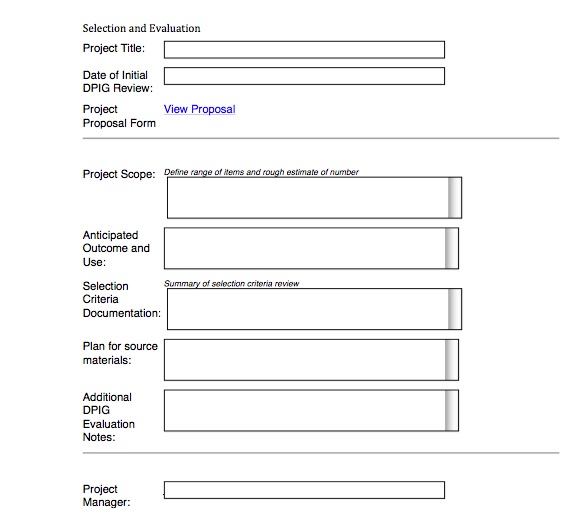A Report from the Digital Projects and Infrastructure Group: Appendices
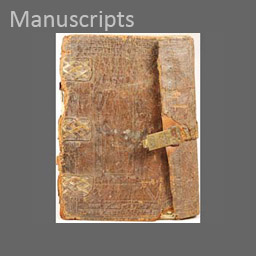 The following appendices correspond to A Report from the Digital Projects and Infrastructure Group (DPIG), September 2011.
The following appendices correspond to A Report from the Digital Projects and Infrastructure Group (DPIG), September 2011.
Appendix II: Detailed Workflows
Proposal, Evaluation, and Selection
Appendix III: Technical Infrastructure
Recommendations for Infrastructure Development
The Major Components of the Infrastructure and Their Behaviors
Appendix IV: Web Form: Proposals for the Digitizing of Library Collections
Appendix V: Proposal Guidelines
Appendix VI: Project Management Worksheet
Appendix VII: Digital Project Item Management Worksheet
Appendix VIII: Example of Shared Staffing Model
Appendix I: Comments on "The Dartmouth Digital Library: Program, Priorities, and Policies (April 2010)" Recommendations
The April 2010 document can be found at /library/admin/docs/DDL-policy.pdf.
The Library should make the Dartmouth Digital Library a priority in fund-raising, staffing, and requests for College innovation funding. This service cannot be successful with current investments alone.
Ongoing: Manton Endowment gift was obtained in 2009 and income has been used to purchase equipment and pay staff salaries. The fund is beginning to provide more income to support staff salaries.
The Library should adopt the Priorities and Principles outlined in this document.
Achieved: The Library has begun or completed selected digitization of library holdings including the Comoediae sex cum argumentis, letters of Samson Occom, and selections of historical films of Dartmouth College. The Library has partnered with the University Press of New England to publish a digital only version of Professor William C. Scott’s, The Artistry of the Homeric Simile, and issue a digital version of his 1974 publication, The Oral Nature of the Homeric Simile. A sample of library exhibits are now available on-line; methods for long term storage of digital objects created for exhibits have been established. Finally, existing electronic journals have been moved into the Dartmouth publication space and the Library has supported publication of newly created electronic journals by Dartmouth editors, the most recent being The Journal of e-Media Studies.
The principles of NISO’s Framework of Guidance for Building Good Digital Collections (2007) have informed our thinking in the formation of the program definitions, policies, and recommendations.
A Director of Digital Initiatives position should be created to lead and develop this new Program, including responsibility for resource attraction.
Not yet accomplished.
A Digital Production Manager position should be created to run the emerging Digital Production Unit. Oversight of digital production should be attached to a department with existing production expertise. Preservation Services is a good candidate.
Not yet accomplished.
An infrastructure to create, deliver, and curate long term digital library assets should be planned, implemented, and added to the Library budget. [Underway: see Library FY10 Goal 4C]
On-going. See Library Goals for FY12.
A Collections Working Group should be established in 2010 to integrate this Digital Program into the existing collection development programs and policies.
Incomplete. Some work has been done within the Collections Management and Planning Group.
A Rights Working Group should be established in 2010 to settle questions of ownership, rights statements, open access, memoranda of understanding with faculty partners, and policies on re-use of digitized content.
Incomplete. Some work has been done within the Collections Management and Planning Group, and by Eliz Kirk and Barbara DeFelice on behalf of DPIG.
Cost-sharing requirements and joint fund-raising opportunities should be discussed with a faculty partner or other collaborator, we will discuss early in the project.
Ongoing: Digitization costs for the Samson Occom letters and the Comoediae sex cum argumentis were identified and underwritten by a grant or the library user.
All Library Staff should be encouraged to gather suggestions for projects and faculty publications and submit them to DPIG.
Achieved: A web form has been successfully used by library staff to submit projects for review, and DPIG responds to requests in a timely fashion.
DPIG should serve as the locus for Digital Project Management processes, workflows, and decisions, consulting with LAG, selectors, and other entities as needed.
Achieved: DPIG members are developing expertise in evaluating project proposals and designing workflows.
Cataloging and Metadata Services should be charged with the metadata design and intellectual access for online collections and the management of the harvestable records that accompany them.
Achieved: A Text Markup Unit has been formed within Cataloging and Metadata Services and a metadata policy is being written.
Preservation Services should be charged with building expertise in digital preservation and formulating long-term curation guidelines for the content built by the Digital Program.
Achieved: A digital preservation policy has been written, and Preservation staff members are active in collaborating with members of DLTG to formulate long-term curation guidelines.
DLTG should continue to provide technical and programming support for the Digital Program, and should expand their consultative role as we explore new processes and infrastructure.
Achieved: Members of DLTG collaborated with staff from Cataloging and Metadata Services and Preservation to identify behaviors of a digital production workflow, metadata repository, and long-term storage repository
Digital Resources should retain direct responsibility for Digital Publishing.
Achieved. The Director of Digital Resources now has 25% of her job assigned to Digital Publishing.
Web Management should be charged with overseeing the Web Team to provide the online delivery of digital collections and publications, including design decisions and the placement of links on the Library website.
Partially achieved. The Web Team has offered support when asked but have not yet been able to lead the online delivery of our collections.
Assessment markers should be built into our structures and processes to make sure the program is efficient and impactful, to cover policy, selection, production, staffing model, curation, and use [as per Library Goal FY12 4b].
Ongoing: Workflow for digital conversion of the Comoediae sex cum argumentis was evaluated including identification of departmental impact and staff costs. The Samson Occom Project is tracking itself closely. New projects are establishing success criteria at the beginning.
Appendix II: Detailed Workflows
Proposal, Evaluation, and Selection
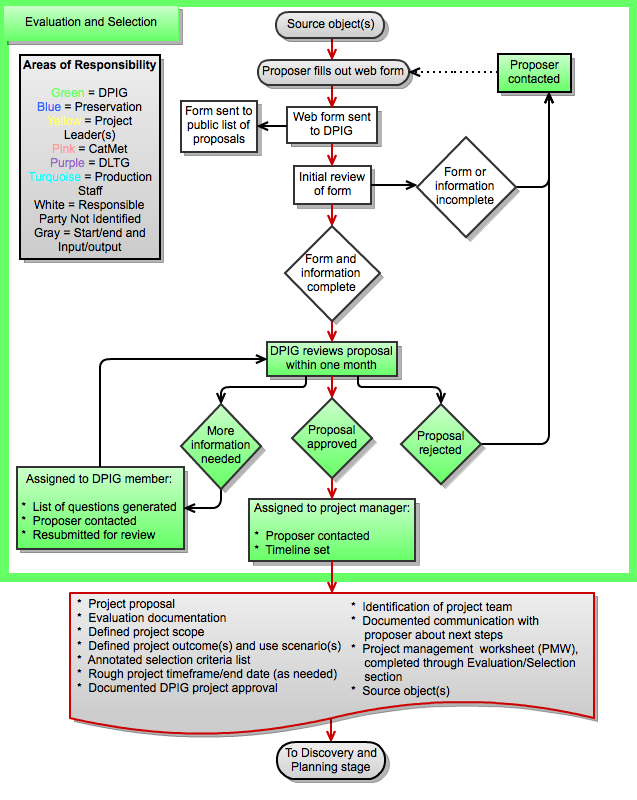
Action: Library staff members propose projects, and a Selection Committee (currently DPIG) evaluates these proposals for digital conversion, applying agreed-upon and publicized selection criteria.
Description: A Project Proposal Form is available in the Library Staff Web and can be completed by any library staff member. Once a proposal has been submitted the completed form is distributed to all DPIG members and a copy of the proposal is made available on StaffWeb for review.
DPIG members apply the Selection Policy for Digitization Projects and determine whether to move forward with the project, return to the proposer for more information, or decide that the project is out of scope.
If the project moves forward, a Project Manager is appointed. See DPIG documentation on the Evaluation and Selection stage.
Outputs: (this stage is completed when these products are completed)
- Project proposal (web form, will need to print/export content) – see Dartmouth Digital Library Program: Processes document1 for information on content of project proposal.
- Evaluation documentation -- additional questions and answers from evaluation process.
- Defined scope of project.
- Defined outcome and scenario(s) for use.
- Annotated Selection Criteria list, with documentation of information gathered for each criterion.
- If a special time frame or fulfillment date is part of the proposal, a defined end date and project timeline has been provided.
- Documented DPIG approval of the project proposal, identification of the project team, and communication with proposer about next steps.
- Physical objects are identified with anticipated methods of transfer and storage during project.
Discovery and Planning
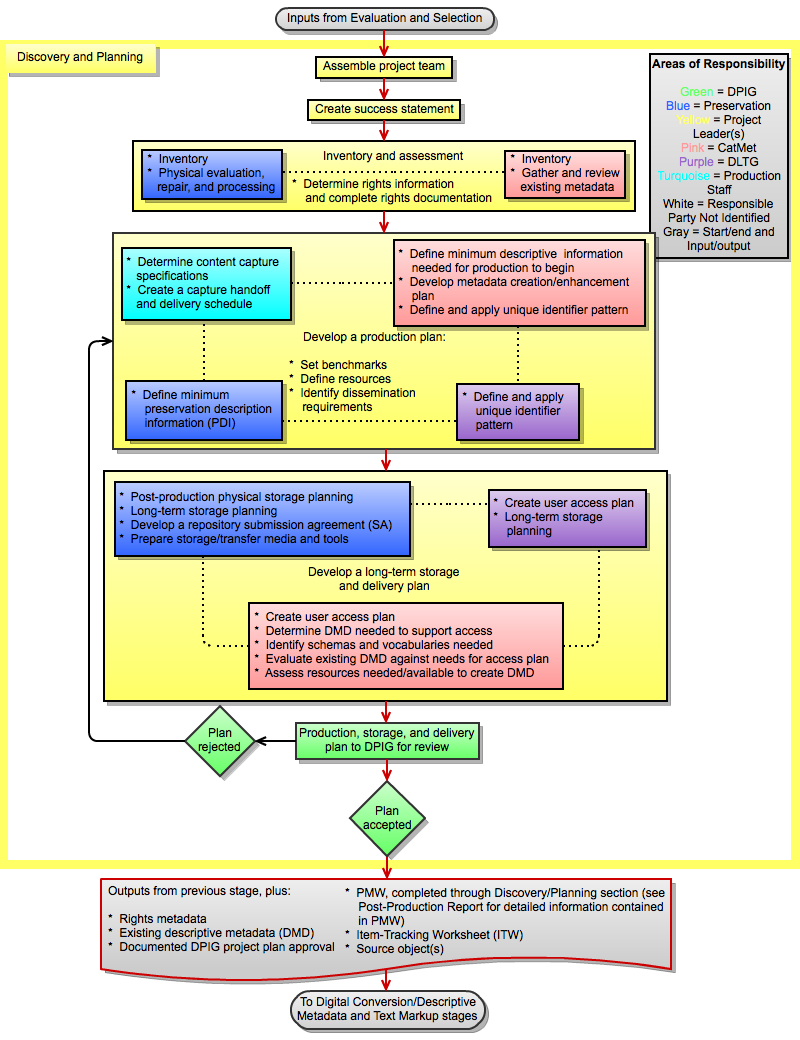
Action: A project team appointed by DPIG conducts a thorough review of the project and – if the decision is still to move forwards -- creates a comprehensive action plan based on input from all relevant areas of expertise.
Description: The Project Manager assembles a project team. The role of the team is to:
-
create a success statement for the project;
-
complete a comprehensive inventory of the source items;
-
assess the source items’ physical condition, existing descriptive metadata, and rights information;
-
develop a detailed plan for executing the project.
The metadata assessment includes an analysis of intended use of the materials, a decision about the delivery system to be used, an inventory of pre-existing descriptive metadata, and an assessment of the time and effort needed to create any additional metadata needed to support the intended use.
The team also completes content capture specifications and long-term storage planning, and forwards the completed project plan to DPIG for approval. See DPIG documentation on the Discovery and Planning stage.
Outputs: (this stage is completed when these products are completed)
-
Outputs from previous stage PLUS:
-
Project Management Worksheet (PMW). PMW will include:
-
Project title and unique identifier for the project.
-
Metadata assessment (Cataloging and Metadata Services):
-
Analysis of the discovery scenarios outlined in the proposal and of available descriptive metadata and/or markup needed to realize the scenarios.
-
Metadata inventory: gather, review and assess descriptive metadata. If available descriptive metadata and/or markup is not adequate, time and effort estimates for the creation of these metadata.
-
Preservation assessment of source objects, with evaluation documentation and a planned repair schedule.
-
Dissemination requirements, to include a list of expected file format(s) and delivery platform(s). If a CONTENTdm delivery is planned, a determination of whether Compound Objects will be created.
-
Digital conversion plan: this will include a schedule for delivery of items to digital conversion unit/vendor, estimated length of time for the digital conversion processes, content capture specifications, and a detailed file naming convention.
-
Long-term storage planning, including an estimate of storage space needed for masters, derivatives, and metadata, and a written submission agreement for ingest of materials into the long-term storage repository.
-
Statement of resources needed to complete project, including staff time, vendor costs, supplies, equipment, and long-term storage and delivery cost estimate.
-
Decision on whether the physical materials will be retained, and if so whether any changes will be made to storage locations or terms of use.
-
Timeline for the project.
-
Rights metadata, including all processes followed and information gathered about rights to use and/or distribute the digitized works, “orphaned” works, decisions to give permissions to use for works we hold rights to.
-
Item Tracking Worksheet: a comprehensive, detailed inventory identifying all physical objects, locations, and eventual disposition.
-
Source objects, with a plan for routing them to next stage (as needed).
-
DPIG approval of the project plan.
Digital Conversion
![]()
Action: The action plan is executed by performing digital conversion and capture of technical metadata.
Outputs: (this stage is completed when these products are completed)
-
Outputs from previous stages, PLUS:
-
PMW, updated to record overall project progress.
-
Digital objects – master files, derivative files and technical metadata recorded in the object.
-
Item Tracking Worksheet updated to include:
-
a list of all digital files created during conversion,
-
a unique identifier generated by the Worksheet and assigned to each file according to Dartmouth Digital Library Program guidelines.
-
technical or preservation metadata not imbedded within the image files.
-
statistics describing time expended and number of files created.
-
Metadata and Markup
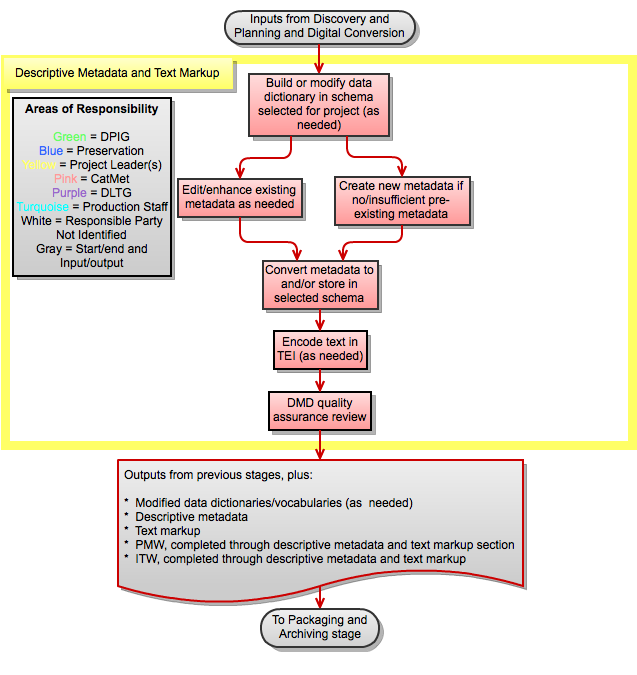
Action: The action plan is executed by creating new and/or repurposing existing descriptive metadata, and by marking up text with XML encoding when necessary. This stage can occur simultaneously with the digital conversion process or at any time thereafter.
During this stage, pre-existing descriptive metadata is reformatted or enhanced for use and/or new descriptive metadata is created, and text markup is created for textual materials. This stage may either precede or follow the shipping of materials to a vendor to digitize.
Action outline:
-
Preparation:
-
Refine inventory and metadata analysis from Discovery and Planning stage as needed.
-
Build or modify data dictionary in schema selected by Cataloging and Metadata Services
-
-
Existing metadata:
-
Evaluate data content
-
If acceptable, convert to/store in schema selected by Cataloging and Metadata Services
-
If not acceptable, edit existing metadata or create new minimum descriptive information
-
Convert to/Store in schema selected by Cataloging and Metadata Services
-
-
No existing metadata:
-
Create minimum descriptive information
-
Convert to/Store in schema selected by Cataloging and Metadata Services
-
-
Text markup
Outputs: (this stage is completed when these products are completed)
-
Outputs from previous stages, PLUS:
-
Applicable data dictionaries/vocabularies, selection of schemas
-
Descriptive metadata (either derived from existing or created up to this point).
-
Text markup.
-
Project Management Worksheet, updated to record overall project progress.
-
Item Tracking Worksheet updated with statistics describing time expended and number of files created.
Packaging and Archiving
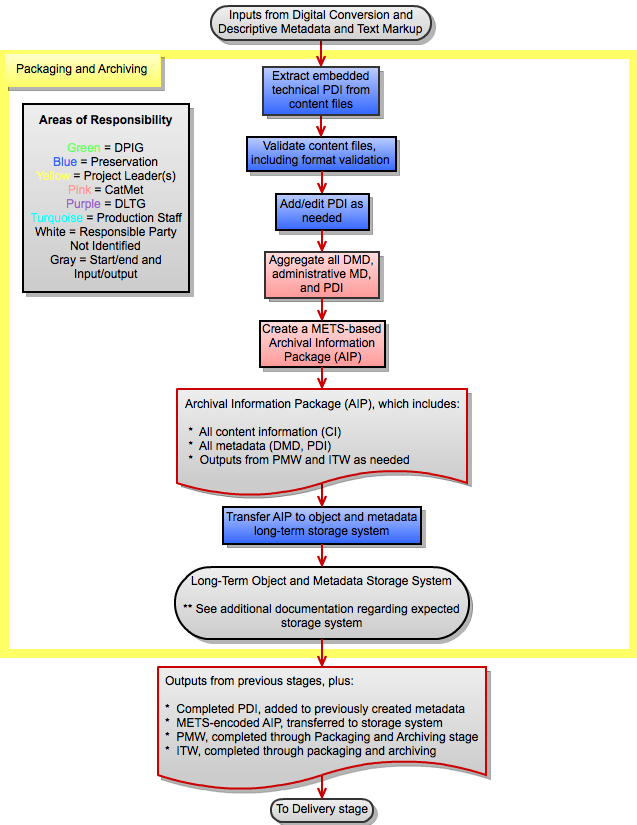
Action: Technical metadata is extracted, preservation metadata is completed, and both are merged with descriptive metadata. Structured associations are created between all object and metadata files, and they are uploaded to long-term storage infrastructure where preservation and data management measures are applied.
Outputs: (this stage is completed when these products are completed)
-
Outputs from previous stages, PLUS:
-
Completed preservation description information (PDI).
-
All metadata created in previous steps (including DMD and PDI), and all unique object identifiers, encoded according to local standards, and either incorporated into, or pointed to from a digital object packaging model.
-
All content and metadata, completed and transferred to long-term storage system.
Delivery
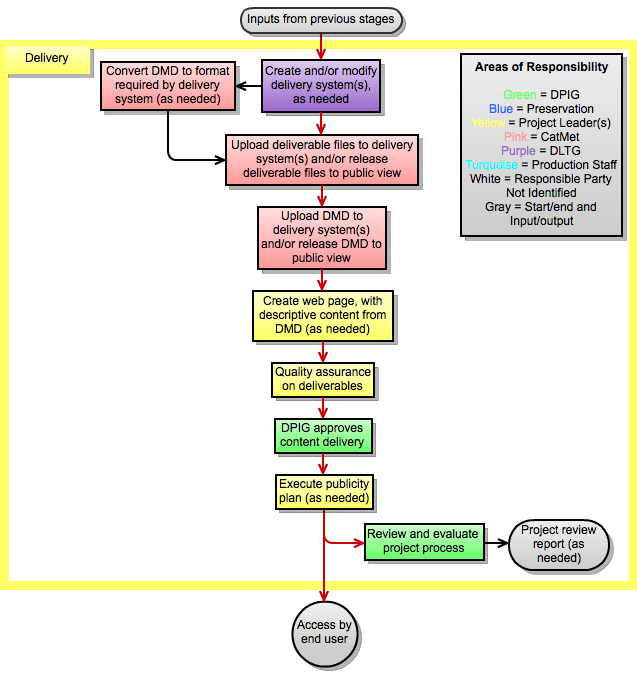
Action: The action plan is executed by creating the user experience defined in the action plan.
Outputs: (this stage is completed when these products are completed)
-
Customized delivery system(s) or interfaces, designed and/or modified as needed.
-
Files of delivery objects and descriptive metadata, formatted to the requirements of the delivery system (e.g. CONTENTdm) as needed.
-
Object files in delivery system(s) (or released to public view if a single repository is in use).
-
Descriptive metadata in delivery system(s) (or released to public view if a single repository is in use).
-
Web page describing the object or collection (generated from descriptive metadata.
-
Publicity materials as described in the PMW.
-
DPIG approval of delivery.
- Project review report.
1 https://libwiki.dartmouth.edu/twiki/pub/Libopen/DPIG/DDLpractice.docx Back to text
Appendix III: Technical Infrastructure
Recommendations for Infrastructure Development
- Identify and/or develop tools that will implement the behaviors defined below, and create a unified tools workspace for library staff. Further develop “behaviors” into actionable specifications for evaluation against available tools. See a preliminary list of possible existing tools to consider at https://libwiki.dartmouth.edu/twiki/bin/view/Libopen/PossibleDigitalProductionTools
- Create a filing/storage system for rights metadata that can provide rights metadata in conformance with existing metadata standards (such as the PREMIS data dictionary) and/or be linked to/from a standardized record structure.
- Create and implement prototypes of the Project Management Worksheet and the Item Tracking Worksheet. Collect feedback from project teams working with the prototypes and modify the worksheets. Creating prototypes includes making decisions about where the data will be stored, how it will be accessed, etc.
- Develop guidelines for the creation of unique object identifiers, (i.e. semantic identifiers that become the basis for URLs) to ensure persistent identification and access, and adjust the existing DPIG file naming policy if/as needed.
- Create documents to define:
-
- Policy and strategies for ongoing updating and maintenance of metadata in the long-term storage system.
-
- The application of compound object technology in CONTENTdm.
-
- Define behaviors for the User Delivery System.
-
- Descriptive metadata policies
-
- Digital Preservation policies
-
-
Generic workflows for known object types (e.g. book out of copyright, photo collection) that are frequently encountered in the Digital Library Program, to simplify and expedite project planning.
-
The Major Components of the Infrastructure and Their Behaviors
Metadata Workspace System
Incorporates behaviors currently associated with XML Collections, including:
- Validates metadata against schemas for standards used by the Digital Library Program
- Imposes version control on metadata files
-
Imposes appropriate levels of restrictions on access and modification of metadata to allow enforcement of local policies and practices
-
Supports local descriptive metadata policies and practices
- Enforces desirable file directory structures and collection identity
Stores in-progress descriptive metadata work, including schemas (for content standards, markup, vocabularies) and descriptive metadata models for each project.
Aggregates administrative metadata (rights, preservation, technical) and descriptive metadata for a given project into a single METS document for upload to Long-term Storage and to delivery systems, and generates the METS structural metadata.
Creates/stores the linking data to link the unique identifier for each digital object and the matching metadata.
Exports metadata in appropriate formats for transfer to Long-term Storage and delivery systems.
Long-Term Object and Metadata Storage System
The expectation is that this system will be a set of interoperable components which, when aggregated, demonstrate the following behaviors:
Long-Term Object Storage:
- Stores archival and deliverable versions of digital objects.
- Complies with relevant standards used by the Digital Library Program.
- Provides a single, unified storage repository for all products of the Digital Library Program.
- Enforces all necessary system security protocols.
- Imposes appropriate levels of restrictions on access to data to ensure long-term preservation.
- Supports preservation management actions on the data it stores (such as automatic format validation on ingest of files).
- Supports user discovery interface, and/or exports to library discovery system(s).
- Has the ability to hide content/images/metadata from users without removing data from the system. Should be able to do this both by collection/set and individual items.
- Supports a variety of access/authorization methods (login, IP, etc.).
Long-Term Metadata Storage:
- Stores metadata and digital objects in appropriate organizational frameworks, and in compliance with library metadata policies.
- Can index, search, and query data.
- Supports metadata export formats used by the Digital Library Program.
- Complies with relevant standards used by the Digital Library Program. Serves as the “database of record” – final versions of metadata are stored here and exported to other systems from here.
- Allows metadata to be accessed by library staff.
- Allows for levels of access that will both restrict access for long-term data preservation and allow editing of data when needed.
The viability of the long-term object and metadata storage system is dependent on these actions being performed:
- Perform periodic preservation audits to ensure content authenticity, accessibility, etc.
- Maintain and review file format and migration information for all content.
- Create and maintain standards, policies, and procedures for use and maintenance of the system.
- Maintain awareness of relevant updates in technology, standards, and preservation management strategies. Test and make recommendations for changes as needed.
- Manage backup procedures as defined by preservation policies.
- Migrate data as needed based on preservation audit results (if this includes format migration, will require changes to preservation metadata).
- Validate content periodically.
- Update and maintain technical components (hardware, software, etc.).
- Engineer and/or implement system changes based on preservation and technology recommendations.
- Update/manage metadata as needed.
- Review content for alignment with collection development goals and possible de-selection as appropriate.
Management Actions to Be Performed on the Long-Term Object and Metadata Storage System
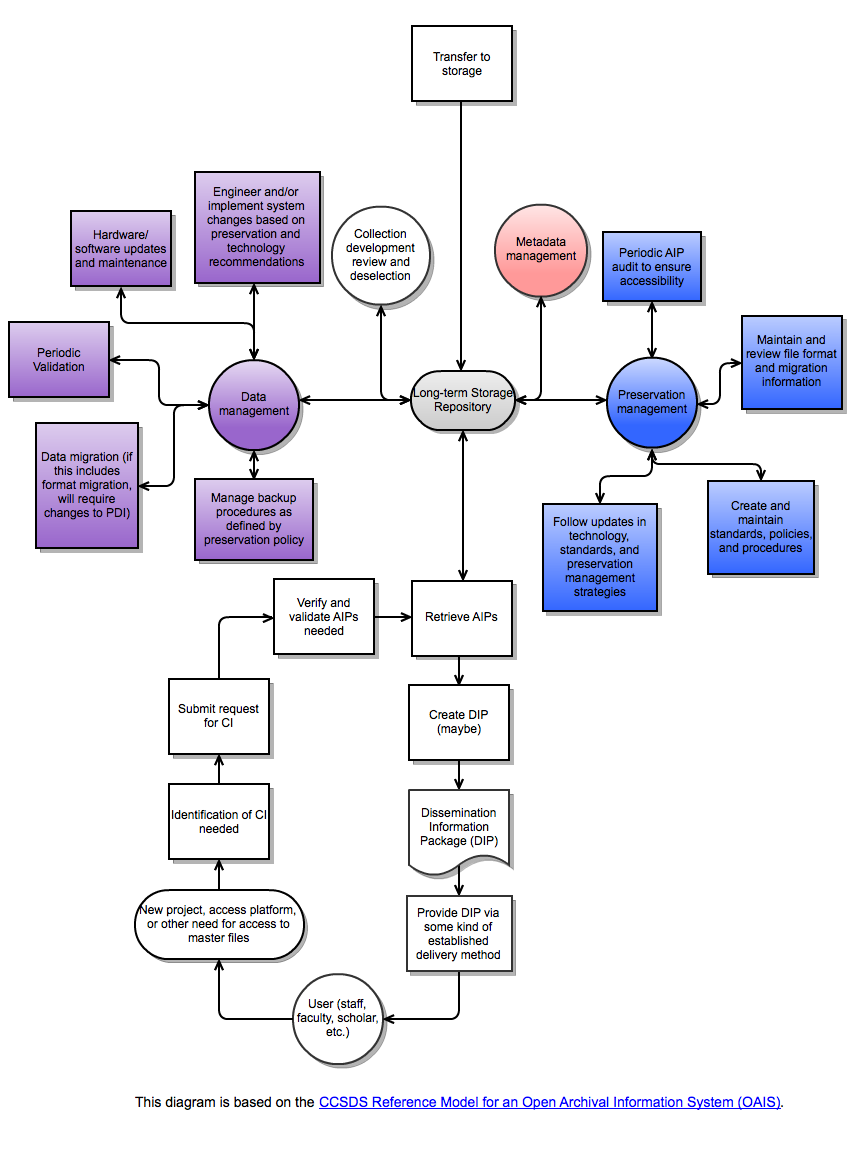
Behaviors of Item Tracking Worksheet
- Is accessible by all staff associated with Digital Library Program activities, from their personal computers.
- Allows creation and editing of inventory lists for analog objects, and actions performed on each analog object including final disposition.
- Allows creation and editing of inventory lists for digital objects, and actions performed on each digital object.
- Generates and/or stores unique object identifiers according to Digital Library Program guidelines (to be developed; see recommendations), and can associate a unique object identifier with each digital object.
- Along with the digital object unique identifier, stores, as needed, the minimum amount of descriptive metadata necessary to identify the object. Does not store the full descriptive metadata or anticipate the descriptive metadata model. Does not store descriptive tags or controlled vocabularies.
- Supports project tracking and management by displaying work status of each object.
- Stores statistical data for execution phases (conversion, metadata/markup, delivery) to express time and effort and items created.
- Exports data (unique identifier, any technical or preservation metadata not wrapped in the digital object, lists of actions performed on objects) to the Metadata workspace system for ingest into selected schemas.
Behaviors of Project Management Worksheet
- Stores documentation of project planning and decisions made about scope, goals, resources, and deliverables for the project.
- Ensures and documents that all project steps are assigned and completed.
- Ensures and documents a general understanding of responsibilities and accountabilities within project team (who will do what).
- Ensures and documents the development of realistic time frames for project fulfillment.
Behaviors of User Delivery System
- Still to be developed.
Appendix IV: Web Form: Proposals for the Digitizing of Library Collections
Dartmouth College Library is soliciting nominations for collections from its holdings that would benefit from digitization, in order to provide wider access, richer pedagogy, and increased research opportunities. See the “Proposal Elements” and “Selection Policy for Digitization Projects” for criteria used to evaluate proposals.
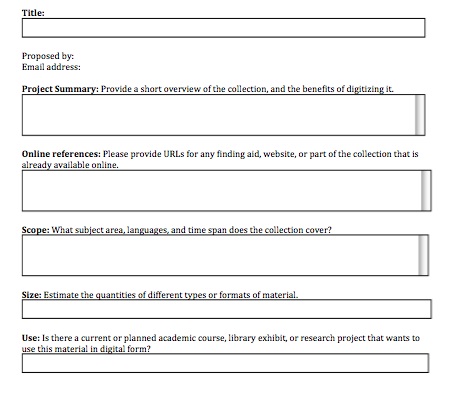
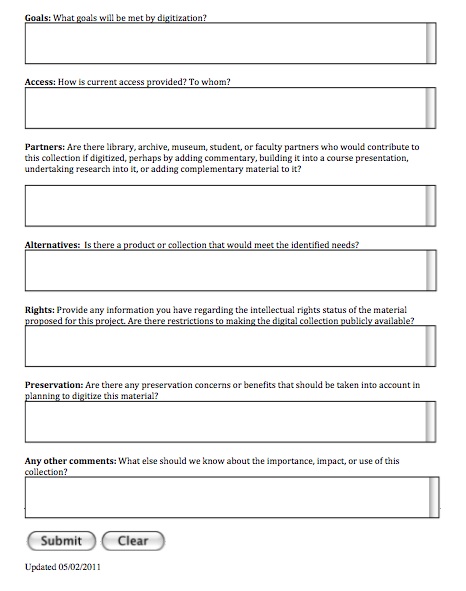
Results of Proposal Web Form – a document sent to DPIG
Title: Terence, Comoediae sex cum argumentis
Proposed by: Jay Satterfield
Project Summary: Disbind, scan, and rebind Codex Ms 001999. A complete scan of this manuscript has been requested by a researcher in Australia with grant funding to cover most or all of the cost. The manuscript gets moderate use in classes, and it is in need of a new binding. This project would provide access to a researcher, create broad digital access, and make the original more stable and accessible.
Online references: Here is the catalog record: http://libcat.dartmouth.edu/record=b1944245~S1
Here is the listing in Script to Pixels: /library/rauner/westmss/001999.html
Scope: The manuscript was created in 1462 in Ferrara. It is in Latin.
Size: There are 112 leaves (or 224 pages) on vellum.
Access: The manuscript is available in the Rauner Library reading room to any researcher.
Use: Nothing local, but a researcher at an Australian university will be using it in a research project focused on marginal comments in Terence manuscripts.
Partners: The researcher can commit funding from her grant.
Rights: There are no rights issues.
Preservation: It is in a 19th-century binding. The front and back boards are detached. The binding structure is too tight to be functional--it does not allow access to the gutters and puts stress on the vellum when opened.
Other comments: The researcher has funds; would need an invoice by November 15th, but understands the actual scanning work would take longer. I prepared an estimate for her with the help of Deborah Howe [redacted]. If at all possible, I need to get back to the researcher this week.
Appendix V: Proposal Guidelines
Proposers will provide this information via the proposal form, and reviewers will use it as a checklist of information needed in a proposal. See also the Selection Policy for Digitization Projects. The first five questions should be addressed in a proposal (they are therefore included as part of the online Proposals Form), and #6, 7, and 8 are additional questions for the evaluation committee:
Proposal Questions
- USE -- Will digitization enhance access and increase use by an identifiable user or user community (faculty, student, staff, alumni, or donor)? Did a user or group of users initiate this project or publication? Does this collection or publication have a relation to the other Dartmouth materials already in digital format and will it contribute to a critical mass of digital materials within a subject area?
- GOALS -- What goals will be met by digitization? Preservation (perhaps by reduce the handling of fragile originals)? Enhanced access? New types of teaching or scholarship? Library priorities?
- ALTERNATIVES -- Does a commercial product or online collection (perhaps from another library) exist that would meet the identified needs?
- VALUE -- Does the collection or publication have enough intrinsic value to ensure interest, and to whom? Internal Dartmouth audience? External scholarly users?
- RIGHTS -- Are rights and permissions for electronic distribution securable? Are there any donor or statutory restrictions that apply to the use of the materials?
- FUNCTION – can we make digital files of sufficient quality to support the intended use? Is there intellectual access to the collection already or will this have to be built?
- RESOURCES -- Are production and delivery costs known and supportable, and can the institution sustain the project into the future? Does the project lend itself to a partnership with a commercial provider, library consortia, or cultural heritage institution, or to an external funding application?
- PRACTICALITY -- Is the local organizational and technical infrastructure adequate for storing, delivering, and preserving this material? Do we have suitable software to deliver the materials? Do we have sufficient expertise to carry through the project?
Appendix VI: Project Management Worksheet
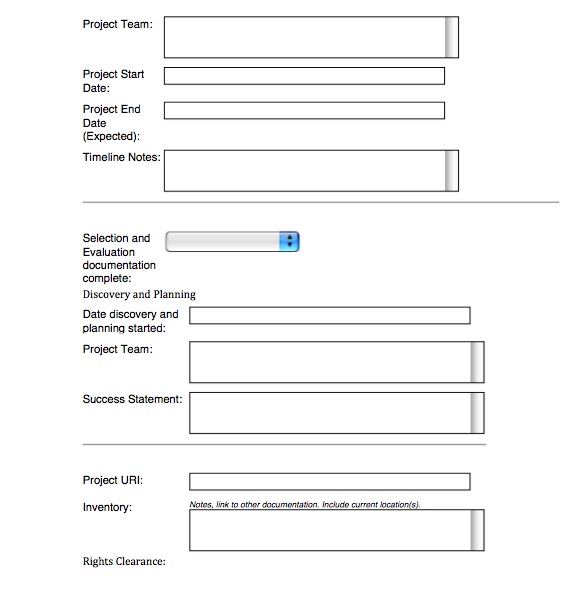
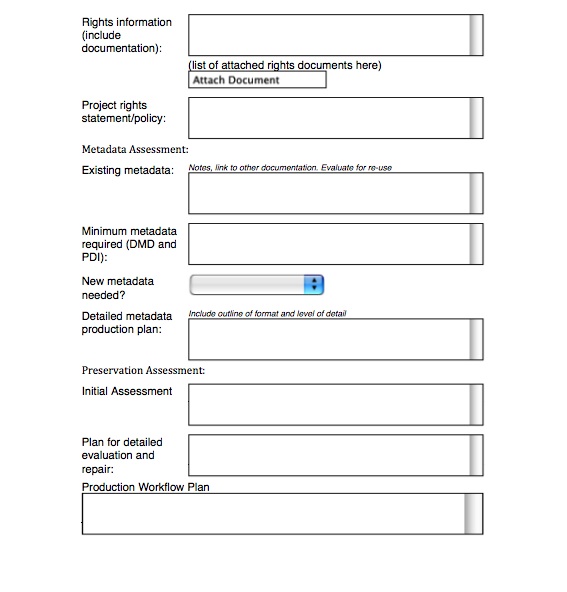
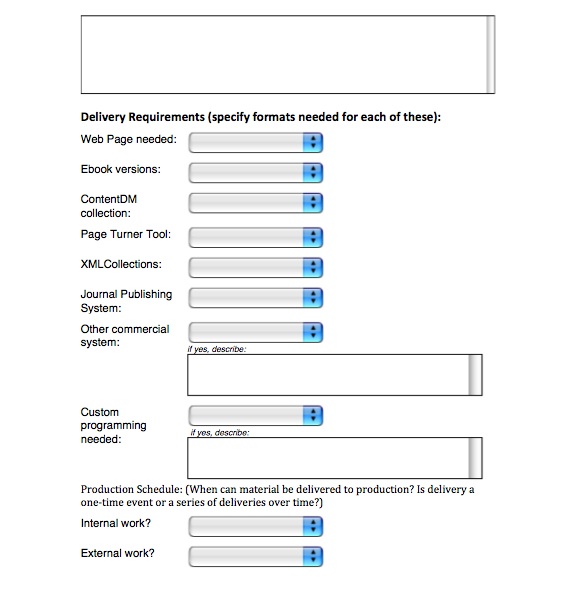
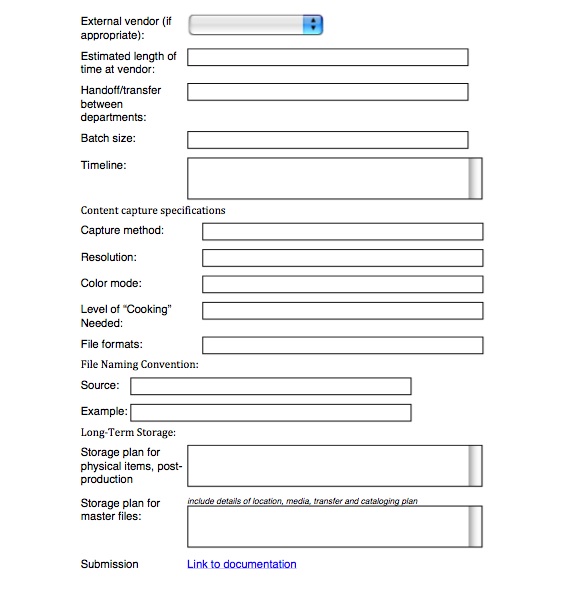
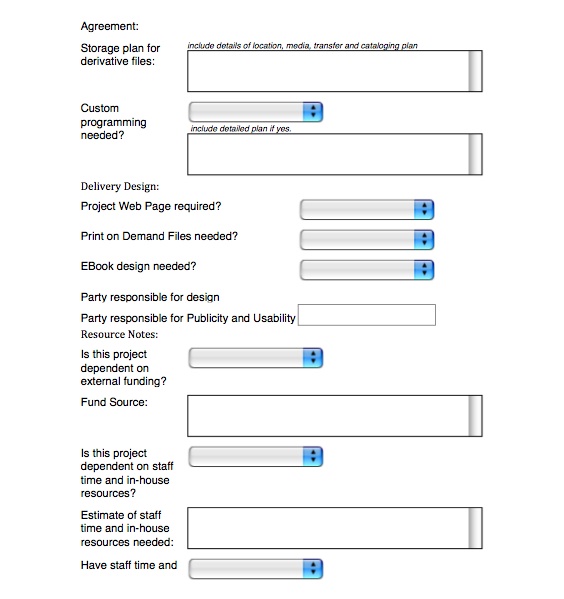
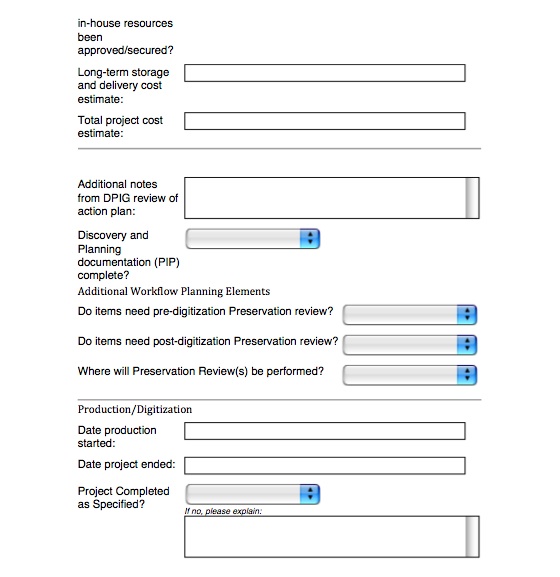
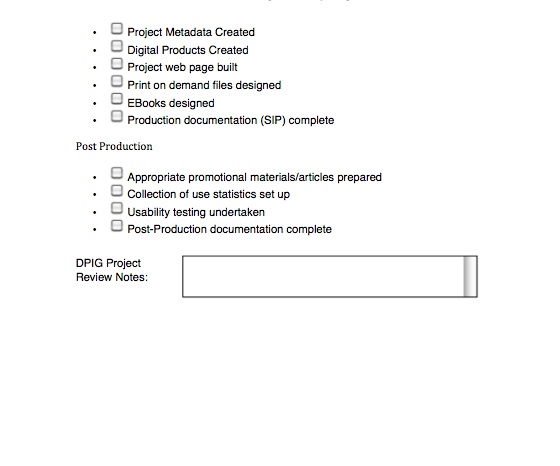
Appendix VII: Digital Project Item Management Worksheet
The following is a draft of the template that will be filled in as an item travels through the various digitization stages. This information in this item management worksheet will be included in the future electronic project management tracking and workflow database, to be created and used as part of the Digital Production Infrastructure.
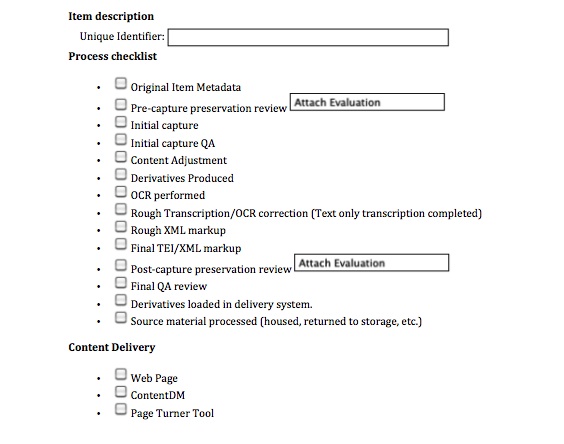
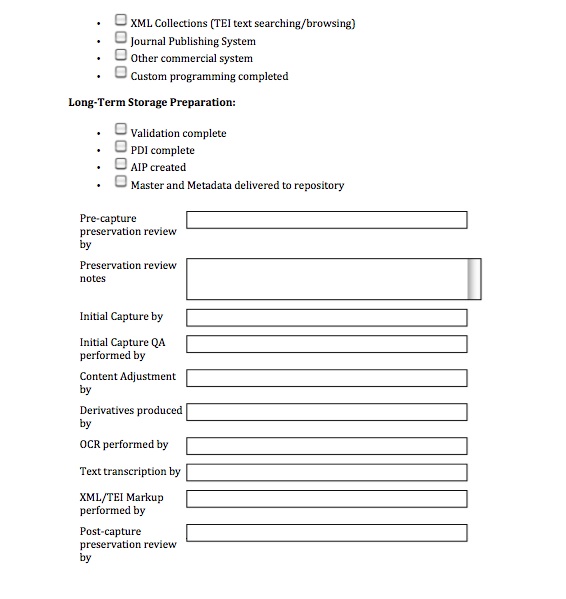
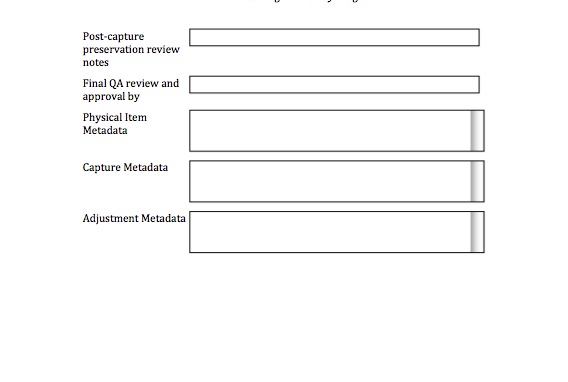
Appendix VIII: Example of Shared Staffing Model
Terence, Comoediae sex cum argumentis Digital Project
Pre-Proposal
November/December 2009:
1) Correspondence between Rauner and Australian professor.
Rauner/Satterfield: 1 hour.
January 2010:
2) Further reference question about the Mss. Interest in the MSS marginalia expressed. Photocopies (images?) of selected pages made and sent (postal mail?) by Joshua Shaw.
Rauner/Shaw: 1 hour.
October 2010:
3) Request came back to have entire Mss. scanned in high resolution. Jay Satterfield evaluated binding and decided it was in need of rebinding. Deborah Howe agreed. Contacted David Seaman to see if it can be scanned.
Rauner/Satterfield: 2 hours corresponding with patron to determine need.
Rauner/Satterfield: 4 hours investigation of Mss.
Production/Seaman: 15 minutes.
Preservation/Howe: 30 minutes.
November/December 2010:
4) Further correspondence between patron and Rauner – we learn that requester can pay for the work but needs to pay an invoice prior to 1 January 2011.
Rauner/Satterfield: 1 hour.
5) Jay and David discuss feasibility of digitizing it and the timing. Drawing on past experience with the Brut Chronicle, and especially the ability to disbind it, the item looked straightforward from a Digital Production perspective. Confident that we can scan to a quality suitable for intended use. Jay discusses disbinding feasibility and timing with Preservation Services.
Rauner/Satterfield: 30 minutes.
Production/Seaman: 30 minutes.
Preservation/Howe: 30 minutes.
6) Jay submits a proposal through the web form designed for this – goes to all members of DPIG.
Rauner/Satterfield: 1 hour.
7) Given the time-sensitivity of the decision, this matter is taken up at the next DPIG meeting. Project approved as described. Main stakeholders – Preservation, Digital Production, Special Collections – all on board. No additional cataloging planned.
Cost estimates for the various stages discussed – digitization, disbinding, shipping of DVD copies to Australia.
Patron to billed at standard, existing Rauner rate of $10 per image plus $585 estimated from Preservation for disbanding.
Timetable established – dis-bind in December; scan in January; deliver in February.
DPIG/30 minutes x 8 participants.
8) Dis-binding with before/after photos completed December 16.
Preservation/Howe: 7 hours.
9) Scan planning completed December 22.
Production/McCoy: 2 hours.
Production
January 2011
10) Raw scanning completed: 4-7 January.
Production/McCoy: 20 hours.
Rauner/Staff: 2 hours for delivery to production and pickup.
11) Image processing and QA: 10-14 January.
Production/McCoy: 20 hours.
12) Image derivatives (thumbnails and JPEG display images) generated and checked for online delivery. 600 DPI 24-bit TIFF derivatives generated to send to patron – high-resolution versions to aid in reading of marginalia.
Production/McCoy: 2 hours.
Delivery
February 2011
13) TEI wrapper built for book; HTML derived from that via existing style sheet.
Delivery/Seaman: 4 hours.
14) PDF built from JPEG files.
Delivery/McCoy: 30 minutes.
15) Website on Digital Collections built, and images loaded.
Delivery/Seaman: 1 hour.
Delivery/McCoy: 3 hours.
16) Documentation prepared to send with the images, including technical details and rights statement.
Delivery/McCoy: 1 hour.
17) Labels designed for DVD cases including rights and contact information.
Delivery/McCoy: 2 hours.
18) Five DVDs burned for patron, and checked. Documentation included on disks.
Delivery/McCoy: 2 hours.
19) DVDs delivered via express shipping. Patron confirms receipt.
Delivery/Rauner staff: 1 hour.
Delivery/Guay: 15 minutes.
20) Re-bind MSS.
Preservation: Howe: 20 hours.
21) Online version linked into library catalog; made public through Digital Collections website.
Delivery/Cataloging and Metadata Services Staff: 30 minutes.
Delivery/Seaman: 30 minutes.
Total Time – all: 105 hours.
Total Time – Rauner: 12 ½ hours
Total Time – Preservation: 28 hours
Total Time – DPIG: 4 hours
Total Time – Production: 44 ¾ hours
Total Time – Delivery: 15 ¾ hours
